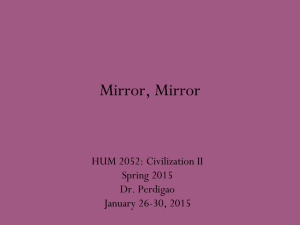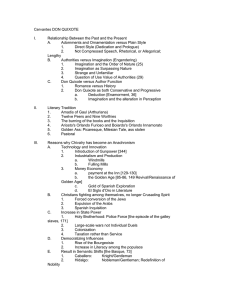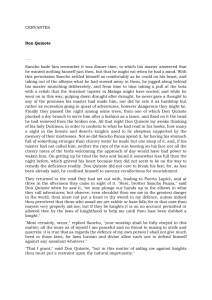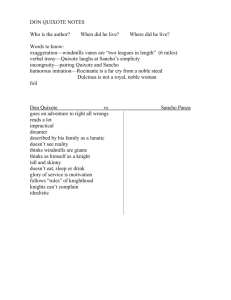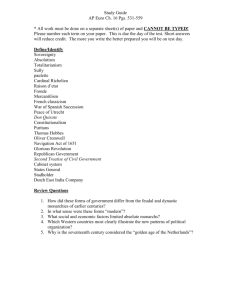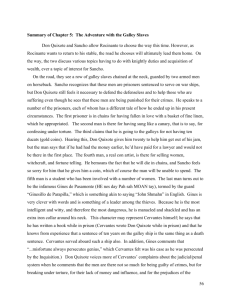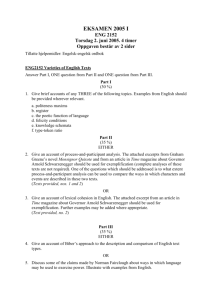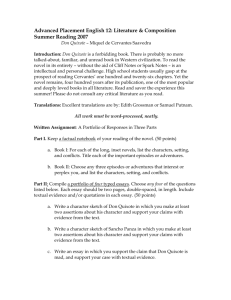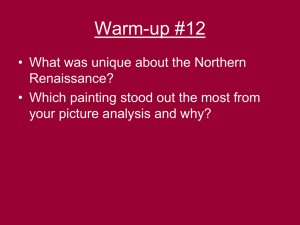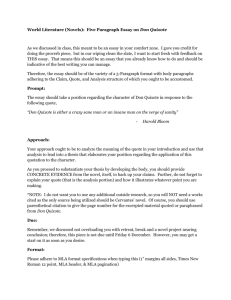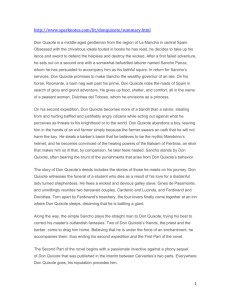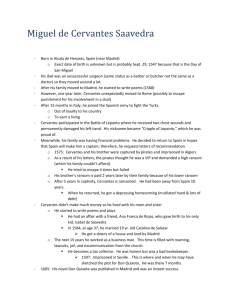Don Quixote's Melancholy
advertisement
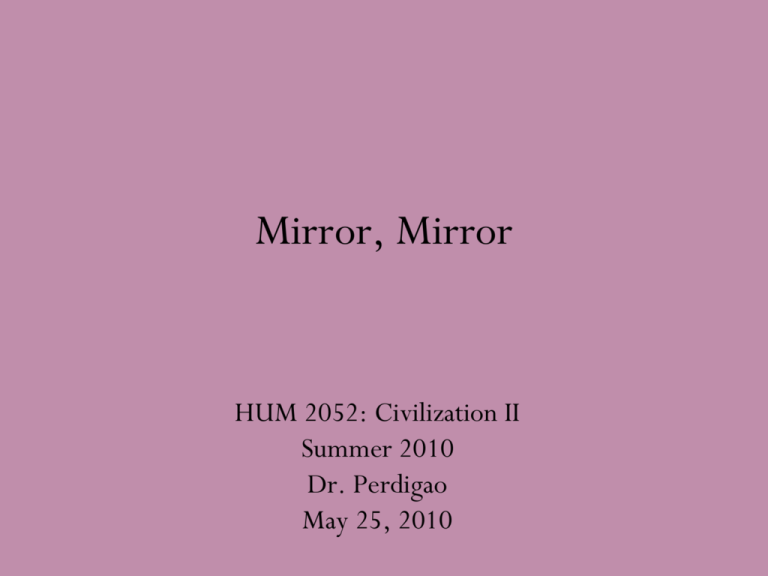
Mirror, Mirror HUM 2052: Civilization II Summer 2010 Dr. Perdigao May 25, 2010 Jose Manuel Merello’s Don Quixote’s Melancholy and Don Quixote http://www.spanishpaintersfromspain.com/ Octavio Ocampo’s Visions of Quixote (1989) http://www.visionsfineart.com/ocampo/visions_of_quixote.html Octavio Ocampo’s Friendship of Don Quixote (1999) http://www.visionsfineart.com/ocampo/friendship_of_don_quixote.html Don Quixote in Images • http://www.donquijote.org/vmuseum/paintings/various/index.a sp?pag=8 • http://beinart.org/artists/octavio-ocampo/ Background Miguel de Cervantes (1547-1616) Enlisted in Spanish fleet, captured by pirates, prisoners at Algiers—held as slave for ransom Freed in 1580, then began writing plays, pastoral romance Galatea Story behind Don Quixote that it was conceived while he was in prison in Seville Part I (1605), Part II (1615)—became popular success but only later “recognized as an important work of literature” (2218) Forms at time: epic, tragedy, pastoral romance As “parody, caricature of a literary type” (2218) to “satirize the romances of chivalry” (2218) Text presents “an individual deciding to live by the standards of that world in a modern and realistic context” (2218) Cervantes’ World • Ferdinand and Isabella (1479-1516), strengthen monarchy, reformation of the church, crusade against Muslims • By 16th century, “purity of blood and orthodoxy of faith became necessary for, and synonymous with, Spanish identity” (Perry 375); persecution of Muslims and Jews, church tribunal, the Inquisition; Columbus’ voyage in New World, North and South America, 1519 with Cortés in Mexico • Charles V (1516-1556), 1519 elected Holy Roman Emperor, but weaknesses, due in part to Lutheran Reformation in Germany, struggle between Catholic Spain and Protestant Europe (Perry 376) • Philip II (1556-1598), “being truly Spanish meant being Christian in faith and blood” (Perry 376), exclusive class of “Old Christians” • Spanish Armada sent from Lisbon in 1588, in “holy crusade” against Queen Elizabeth, met crushing defeat, strengthens Protestant cause, “golden age” of Queen Elizabeth (1558-1603) Contextualizing Quixote • Epic, tragedy, pastoral romance as conventional genres; DQ crosses boundaries as modern text, satirizing conventions of chivalric romance • All epics as quests—DQ as new form of the epic • Deciding to live by the standards of that world in modern and realistic context, revitalizing the chivalric code in modern times • Appearance and reality; reality and illusion; reason and imagination; reason and madness (2219-2220) • “Who am I?” Mirroring Ourselves • Chivalry as an ideal, searching in life is defining spiritual • Theological and spiritual quest of DQ • Picaresque novel: corrupt society, hero from lower class • Earthiness • Idealism • Nobleness, higher notion of chivalry • Objective vs. subjective • Identification with DQ—best and worst in human nature Madness or Creativity? • Stagnancy of his existence • Age 50—midlife crisis • Question of generation and regeneration • Genesis, Adamic creation, with naming of self, horse, love • Is he crazy from reading novels or does he read to prevent going crazy? • Creates another reality to place himself within • Windmill jousts: his inner need to impose concerns on external reality Perspectives • Madness compels him to life—not out • New life is richer than his present existence • Ways in which reality changes to beholder • The book’s existence—preceding this text, as original text (in romance tradition) • Part II—comment on the existence of the self • Hall of mirrors within the text, like Velasquez’s painting • Psychology of DQ places you in and out of self Precursor to Postmodernism? • Alienation within text—reminder it is only a text—not trapped in illusions— aesthetic, emotional, rhetorical distances vital to reading • Prologue about not writing a prologue • Self-referential world, story about storytelling, fiction within fiction, as metafiction • Through madness, he goes sane • “All the world’s a stage and we are merely players” “Merely Players?” • Illusion conjuring image • Allusion referring to something • Elusion escaping • All is play-acting • Enchantment—disenchantment • Illusion—disillusion • How does one reach reality—through illusion? • What is real? “Merely Players?” “I know who I am and who I may be, if I choose” (2244) La Mancha Alonso Quejana Rocinante Dulcinea del Toboso Episodes Innkeeper Andres/Juan Haldudo Housekeeper, niece, curate, barber: problem with books Sancho Panza, promise Windmills (2247) Friars, Biscayan Chapters 8-9: loses historical account, missing pieces Metatexts • “The Ballad that Antonio Sang” (2263-2264) as metafictional text • Shattered his illusions (2273)—tale told by Ambrosio—“end the tragedy” • Grisóstomo’s story as parallel: “Grisóstomo’s Song” (2275-2277) • As pastoral in Part I—with songs telling DQ’s story in another context • The Life of Ginés de Pasamonte—unfinished text—as life (2290)—“that it will cast into the shade Lazarillo de Tormes and all others of that sort that have been or will be written” (2289), 15th century picaresque novel • God as judge, disavows laws of state (2290-91), frees prisoners and renames himself Knight of the Mournful Countenance (2291)—impossible so instead says Credos and Hail Marys, robbed • Goatherd hears DQ and recognizes stories from books (2293) • Turns against Catholic faith (2295) • Homecoming story by the end of Part I The Book Within • “Put into a Book”—Carrasco telling them of the success of part I; makes no sense to them because of timeframe of the story (“the blood of the enemies he had slain was not yet dry on the blade of his sword; and here they were trying to tell him that his high deeds of chivalry were already circulating in printed form” (2301)) • “If it was true that such a history existed, being about a knight-errant, then it must be eloquent and lofty in tone, a splendid and distinguished piece of work and veracious in its details” (2301); reference to Cid Hamete Benengeli • Tells of important adventures—windmills, fulling mill, sheep, burial, freeing of slaves, Benedictine giants and Biscayan (2302-3) • “You may be sure that Aeneas was not as pious as Vergil would have us believe, nor was Ulysses as wise as Homer depicts him” (2303) • “That is true enough . . . But it is one thing to write as a poet and another as a historian. The former may narrate or sing of things not as they were but as they should have been; the latter must describe them not as they should have been but as they were, without adding to or detracting from the truth in any degree whatsoever” (2303) Shattering the Illusion • Knight of the Wood (2307; Pt. II, Chapter 12)—then Chapter 15, Knight of the Mirrors—introduces Casildea de Vandalia (his version of Dulcinea), squire (2310), says he defeated Don Quixote (2317) • Play with self-referentiality, the text within the text as characters discuss their stories with their “mirrors” • Don Quixote says to Sancho: “holding up a mirror for us at each step that we take, wherein we may observe, vividly depicted, all the varied aspects of human life; and I may add that there is nothing that shows us more clearly, by similitude, what we are and what we ought to be than do plays and players” (2307). • Transform the Knight of the Mirrors to Sansón Carrasco—like windmill adversary, under enchantment but really Tomé Cecial (Sancho’s neighbor) with him • In response to Tomé, Sansón says, “the one who cannot help being crazy will be so always, while the one who is a madman by choice can leave off being one whenever he so desires” (2324). Story of plot to bring Don Quixote back revealed (2324) • Sir Knight of the Mournful Countenance: Knight of the Lions; Knight of the Greencolored Greatcoat • Break in the story (2335): “mirror wherein all the valiant of the world may behold themselves”—relating the story of his death, then return to action Denouement • Knight of the White Moon; Sancho “brokenhearted” because “all this was something that was happening in a dream and that everything was the result of magic” (2341); own hopes “whirled away” • Now Knight of the White Moon—Sansón Carrasco, seeking return of DQ “whose madness and absurdities inspire pity in all of us” (2341)—after defeat, DQ must return home for a year • Don Antonio: “most charming madman”; “Do you not see that the benefit accomplished by restoring Don Quixote to his senses can never equal the pleasure which others derive from his vagaries?” (2342) • Sansón “composing pastoral or courtly verses or whatever may come to mind, by way of a diversion for us” (2344) • Finally, presence of God—his sins (2347), returns to self like Sansón but Sansón encourages illusion • “he is a sane man” (2348) • “I was Don Quixote de la Mancha, and now I am, as I have said, Alonso Quijano the Good” (2348) • Apology to Cervantes with disavowal of the story, to author of false sequel The Sense of an Ending • Denouement as spiritual conversion, from knight-errantry to Christianity (Perceval?) • Happy ending in spiritual sense • No reason for his death except his melancholy • DQ ultimately realizes who he is and denies all doings on deathbed as illusions, dies a Christian death • Quixote is not mad but sane and artistically cruel, enjoying the madness he creates, play-acts for power • Is conversion play-acting? (connection to Hamlet) • Quixote to be loved or shunned? Last Act(s) • Is society or the individual insane? • Is quixotic quest inherent to human condition, thus showing us the flaws in ourselves? • Dulcinea in center of piece like Velasquez’s king and queen, but never seen— play with inside and outside • For Montaigne, illusion finally breaks down—question of “Who am I?” remains… “the greatest madness man can be guilty of in his life is to die without good reason” (2348). • Sancho and Quixote in process of education, to teach each other • Denounces books but returns with one last heroic tale in final verses • Last reference to Cid Hamete Benengeli as “original” author
